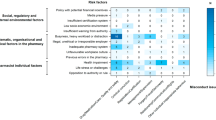Abstract
The Drug-Free Workplace Act of 1988 mandated written drug abuse policies for recipients of certain government grants and contracts. The literature has reported costly side effects of employee drug abuse such as decreased productivity and increased use of health benefits. Furthermore, litigation involving drug abuse policies has been increasingly won by employers. More than 90% of Fortune 1000 companies have adopted formal drug abuse policies. Using content analysis techniques, the current study examined the written substance abuse policies of 30 large American teaching hospitals. Results showed substantial variation in the style and content of the policies. In general, language used in the policies was vague. The study cites the potential use of strategic ambiguity in the development of the policies.
Similar content being viewed by others
References
Drug-Free Workplace Act of 1988, 41 U.S.C. §§ 701–707 (1988).
Lange WR, Cabanilla BR, Moler G, et al.: Preemployment drug screening at the Johns Hopkins Hospital, 1989 and 1991.American Journal of Drug and Alcohol Abuse 1994; 20:35–46.
Holthaus D: Employers get broader power to fight drug use.Hospitals, August 5, 1989, p. 44.
Von Burg L, Forman MA: Substance abuse among nurses at teaching hospitals.Nursing Management, November 1992, pp. 68–70.
Callery YC: Chemical abuse rehabilitation for hospital employees: Examination of benefit usage when referred by an employee assistance professional.American Association of Occupational Health Nurses Journal 1994; 42(2):67–75.
Crouch DJ, Webb DO, Peterson LV, et al.: A critical evaluation of the Utah Power and Light Company's substance abuse management program: Absenteeism, accidents, and costs. In: Gust SW, Walsh JM (Eds.):NIDA Research Monograph 91: Drugs in the Workplace—Research and Evaluation Data. Rockville, MD: National Institute on Drug Abuse, 1989, pp. 169–193.
Peterson AC: The war on drugs: Testing fair and square.Security Management, May 1990, pp. 40–46.
Data watch—Survey outlines hospital employee health benefits.Hospitals, January 5, 1993, pp. 50, 52.
Eubanks P: Chicago hospitals: No drug abusers need apply.Hospitals, July 5, 1990, p. 79.
McCormick B: Johns Hopkins breaks controversial new ground in drug testing.Trustee, July 1990, pp. 16–17.
Smith B: Employee-supported drug testing.Personnel Journal, October 1988, pp. 134–137.
Cronin-Stubbs D, Schaffner JW: Professional impairment: Strategies for managing the troubled nurse.Nursing Administration Quarterly 1985; 9(3):44–54.
Fiesta J: The impaired nurse: Who is liable?Nursing Management, October 1990, pp. 20, 22.
Fenton JW, Jr., Kinard JL: A study of substance abuse testing in patient care facilities.Health Care Management Review 1993; 18(4):87–95.
LaGodna GE, Hendrix MJ: Impaired nurses: A cost analysis.Journal of Nursing Administration 1989; 19(9):13–18.
Nemes J: Hospitals investigate suspected drug abuse.Modern Healthcare, September 29, 1989, pp. 34–35.
Montoya ID, Richard AJ: The case for a code of ethics in an ambulatory care setting.Journal of Ambulatory Care Management 1995; 18(3):69–77.
De Sanctis D: Helping health care professionals confront substance abuse.Trustee, December 1991, p. 13.
Arkus C: Developing hospital policy on impaired practitioners.Trustee, July 1992, pp. 14–15.
Fonn M: Limiting access to drugs.Journalen Sykepleien 1993; 81(7):24.
Kelly M, Mynatt S: Addiction among nurses: Does the health care industry compound the problem?Health Care Management Review 1990; 15(4):35–42.
Firth-Cozens J: Emotional distress in junior house officers.British Medical Journal Clinical Research Edition 1987; 295:533–536.
Koran LM, Litt IF: House staff well-being.Western Journal of Medicine 1988; 148:97–101.
Plant ML, Plant MA, Foster J: Stress, alcohol, tobacco and illicit drug use amongst nurses: A Scottish study.Journal of Advanced Nursing 1992; 17:1057–1067.
Brice J: Confronting drug abuse on the job.Healthcare Forum Journal, January–February 1990, pp. 25–29.
Nemes J: Fighting drug abuse in operating rooms.Modern Healthcare, July 29, 1991, pp. 60, 62.
Dabney D: Workplace deviance among nurses: The influence of work group norms on drug diversion and/or use.Journal of Nursing Administration 1995; 25(3):48–55.
Davee P, Tranbarger RE: A hospital-based program for recovering chemically-dependent nurses.Nursing Management, October 1990, pp. 33–35.
Tanner J, Kinard J, Cappel S, et al.: Substance abuse and mandatory drug testing in health care institutions. Health Care Management Review 1988; 13(4):33–42.
Stritter FT: Managing the educational process. In: Ridky J, Sheldon GF (Eds.):Managing in Academics: A Health Care Model. St. Louis, MO: Quality Medical Publishing, 1993, pp. 230–243.
The AHA Guide to the Health Care Field. Chicago: American Hospital Association, 1993.
Berg BL:Qualitative Research Methods for the Social Sciences. Boston: Allyn & Bacon, 1989.
Kerlinger FN:Foundations of Behavioral Research. New York: Holt, Rinehart & Winston, 1973.
Holsti OR: Content analysis. In: Lindzey G, Aaronson E (Eds.):The Handbook of Social Psychology. Reading, MA: Addison-Wesley, 1986.
Geurin VT, Kohut GF: Content analysis of substance abuse policies in Fortune 500 companies.Journal of Business and Economic Perspectives 1990; 16(2):37–43.
Irwin D:Deviance in the Workplace: Case Studies of Drug Testing in Large Organizations. San Francisco: Mellen Research University Press, 1991.
Axel H: Characteristics of firms with drug testing programs. In: Gust SW, Walsh JM (Eds.):NIDA Research Monograph 91: Drugs in the Workplace—Research and Evaluation Data. Rockville, MD: National Institute on Drug Abuse, 1990, pp. 19–226.
Montoya ID, Richard AJ: A comparative study of codes of ethics in health care facilities and energy companies.Journal of Business Ethics 1994; 13:713–717.
Burke K:A Rhetoric of Motives. Berkeley: University of California Press, 1969.
Lehman WEK, Simpson DD: Patterns of drug use in a large metropolitan workforce. In: Gust SW, Walsh JM, Thomas LB, et al. (Eds.):Drugs in the Workplace: Research and Evaluation Data. Vol. 2. NIDA Research Monograph 100, DHHS Publication No. (ADM)91-1730. Washington, DC: Government Printing Office, 1990.
Laufenburg HF, Barton BA: Attitudes of family practice residency program directors toward mandatory preemployment drug testing.Family Medicine 1997; 29:625–628.
Author information
Authors and Affiliations
Corresponding author
Rights and permissions
About this article
Cite this article
Montoya, I.D., Carlson, J.W. & Richard, A.J. An analysis of drug abuse policies in teaching hospitals. The Journal of Behavioral Health Services & Research 26, 28–38 (1999). https://doi.org/10.1007/BF02287792
Issue Date:
DOI: https://doi.org/10.1007/BF02287792




